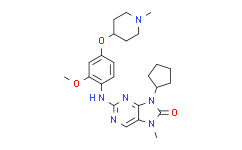| Cas No.: | 1124329-14-1 |
| Chemical Name: | 9-Cyclopentyl-2-(2-methoxy-4-(1-methylpiperidin-4-yloxy)phenylamino)-7-methyl-7H-purin-8(9H)-one |
| Synonyms: | 8H-Purin-8-one, 9-cyclopentyl-7,9-dihydro-2-[[2-methoxy-4-[(1-methyl-4-piperidinyl)oxy]phenyl]amino]-7-methyl-;AZ 3146;AZ-3146;8H-Purin-8-one, 9-cyclopentyl-7,9-dihydro-2-[[2-methoxy-4-[(1-methyl-4-piperidinyl)oxy]phenyl]...;AZ 3146 (AZ-3146);hesperadine;9-cyclopentyl-2-({2-methoxy-4-[(1-methylpiperidin-4-yl)oxy]-phenyl}amino)-7-methyl-7,9-dihydro-8H-purin-8-one;9-cyclopentyl-2-(2-methoxy-4-(1-methylpiperidin-4-yloxy)phenylamino)-7-methyl-7H-purin-8(9H)-one;CS-0883;9-Cyclopentyl-7,9-dihydro-2-[[2-methoxy-4-[(1-methyl-4-piperidinyl)oxy]phenyl]amino]-7-methyl-8H-purin-8-one;AZ3146;9-Cyclopentyl-2-[[2-methoxy-4-[(1-methylpiperidin-4-yl)oxy]-phenyl]amino]-7-methyl-7,9-dihydro-8H-purin-8-one;AK174927;9-cyclopentyl-2-[2-methoxy-4-(1-methylpiperidin-4-yl)oxyanilino]-7-methylpurin-8-one;9-cyclopentyl-2-({2-methoxy-4-[(1-methyl |
| SMILES: | O(C1C([H])=C([H])C(=C(C=1[H])OC([H])([H])[H])N([H])C1=NC([H])=C2C(=N1)N(C(N2C([H])([H])[H])=O)C1([H])C([H])([H])C([H])([H])C([H])([H])C1([H])[H])C1([H])C([H])([H])C([H])([H])N(C([H])([H])[H])C([H])([H])C1([H])[H] |
| Formula: | C24H32N6O3 |
| M.Wt: | 452.5493 |
| Sotrage: | 2 years -20°C Powder, 2 weeks 4°C in DMSO, 6 months -80°C in DMSO |
| Description: | AZ3146 is a reasonably potent and selective Mps1 inhibitor with IC50 of 35 nM for Mps1Cat. |
| In Vitro: | In in vitro kinase assays, AZ3146 inhibits human Mps1Cat with IC50 of ~35 nM. AZ3146 also efficiently inhibits autophosphorylation of full-length Mps1 immunoprecipitated from human cells[1]. TTK specific kinase inhibitor AZ3146 can decrease HCC cell growth. In vitro cell cytotoxicity assays are performed on SMMC-7721 and BEL-7404 cells. IC50s are calculated as being 7.13 μM (BEL-7404) and 28.62 μM (SMMC-7721). Both cells are further treated under the concentration of IC50 for 4 days. Significant inhibitions of cell proliferation are observed[2]. HCT116 cells are cultured for 10 days in 0.8 μM (the GI50) of AZ3146 , then 2 μM AZ3146 for 3 weeks. Sixteen clones are isolated and cell lines generated, named AzR1-16, all of which are resistant to AZ3146-induced cell death in cell viability assays; AzR3 and 4 have a GI50 of approximately 3 μM (4-fold resistance), while the remaining clones have a GI50 of approximately 9 μM (11-fold resistance). When analyzing mitosis by time-lapse microscopy, while 2 μM AZ3146 causes the parental cell line to rapidly exited mitosis in 10 minutes[3]. |

 DC Chemicals' products qualify for U.S. tariff exemptions. We guarantee no price increases due to customs duties and maintain stable supply, continuing to deliver reliable research solutions to our American clients.
DC Chemicals' products qualify for U.S. tariff exemptions. We guarantee no price increases due to customs duties and maintain stable supply, continuing to deliver reliable research solutions to our American clients.





















